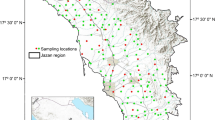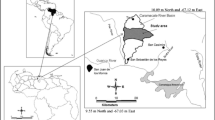Abstract
Characterization of soil water retention, e.g., water content at field capacity (FC) and permanent wilting point (PWP) over a landscape plays a key role in efficient utilization of available scarce water resources in dry land agriculture; however, direct measurement thereof for multiple locations in the field is not always feasible. Therefore, pedotransfer functions (PTFs) were developed to estimate soil water retention at FC and PWP for dryland soils of India. A soil database available for Arid Western India (N=370) was used to develop PTFs. The developed PTFs were tested in two independent datasets from arid regions of India (N=36) and an arid region of USA (N=1789). While testing these PTFs using independent data from India, root mean square error (RMSE) was found to be 2.65 and 1.08 for FC and PWP, respectively, whereas for most of the tested ‘established’ PTFs, the RMSE was >3.41 and >1.15, respectively. Performance of the developed PTFs from the independent dataset from USA was comparable with estimates derived from ‘established’ PTFs. For wide applicability of the developed PTFs, a user-friendly soil moisture calculator was developed. The PTFs developed in this study may be quite useful to farmers for scheduling irrigation water as per soil type.






Similar content being viewed by others
References
Adhikary P P, Chakraborty D, Kalra N, Sachdev C B, Patra A K, Kumar S, Tomar R K, Chandna P, Raghav D, Agrawal K and Sehgal M 2008 Pedotransfer functions for predicting the hydraulic properties of Indian soils; Soil Res. 46(5) 476–484.
Balland V, Pollacco J A P and Arp P A 2008 Modeling soil hydraulic properties for a wide range of soil conditions; Ecol. Model. 219 300–316.
Bell M A and Van Keulen H 1996 Effect of soil disturbance on pedotransfer function development for field capacity; Soil Technol. 8(4) 321–329.
Bhattacharya T, Sarkar D and Pal D K 2009 Soil Survey Manual, NBSS & LUP Publication No. 146, National Bureau of Soil Survey & Land Use Planning (Indian Council for Agricultural Research), Nagpur, India, 400p.
Botula Y D, Nemes A, Mafuka P, Van Ranst E and Cornelis W M 2013 Prediction of water retention of soils from the humid tropics by the nonparametric-nearest neighbor approach; Vadose Zone J. 12(2) 1–17, https://doi.org/10.2136/vzj2012.0123.
CAZRI 2008 Annual Report; Central Arid Zone Research Institute, Jodhpur, India.
Chakraborty D, Mazumdar S P, Garg R N, Banerjee S, Santra P, Singh R and Tomar R K 2011 Pedotransfer functions for predicting points on the moisture retention curve of Indian soils; Indian J. Agric. Sci. 81(11) 1030.
Cornelis W M, Ronsyn J, van Meirvenne M and Hartmann R 2001 Evaluation of pedotransfer functions for predicting the soil moisture retention curve; Soil Sci. Soc. Am. J. 65 638–648.
D’Odorico P, Bhattachan A, Davis K F, Ravi S and Runyan C W 2013 Global desertification: Drivers and feedbacks; Adv. Water Res. 51 326–344.
Gupta S C and Kapoor V K 2000 Fundamentals of mathematical statistics: A modern approach; Sultan Chand and Sons.
Gupta S C and Larson W E 1979 Estimating soil water characteristics from particle size distribution, organic matter percent, and bulk density; Water Resour. Res. 15 1633–1635.
Haghverdi A, Leib B G and Cornelis W M 2015 A simple nearest-neighbor technique to predict the soil water retention curve; Trans. ASABE 58(3) 697–705.
Hodnett M G and Tomasella J 2002 Marked differences between van Genuchten soil water-retention parameters for temperate and tropical soils: A new water-retention pedo-transfer functions developed for tropical soils; Geoderma 108 155–180.
Khlosi M, Alhamdoosh M, Douaik A, Gabriels D and Cornelis W M 2016 Enhanced pedotransfer functions with support vector machines to predict water retention of calcareous soil; Eur. J. Soil Sci. 67(3) 276–284.
Klute A 1986 Water retention: Laboratory methods; In: Methods of soil analysis. Part I: Physical and Mineralogical Methods. Agronomy Series 9, 2nd edn, American Society of Agronomy, Madison, WI, USA, pp. 635–662.
Millennium Ecosystem Assessment 2005 Ecosystems and human well-being: Desertification synthesis; World Resources Institute, Washington, DC.
Minasny B and McBratney A B 2002 The neuro-m method for fitting neural network parametric pedotransfer functions; Soil Sci. Soc. Am. J. 66 352–361.
Mohanty M, Sinha N K, Painuli D K, Bandyopadhyay K K, Hati K M, Reddy K S and Chaudhary R S 2015 Modelling soil water contents at field capacity and permanent wilting point using artificial neural network for Indian soils; Nat. Acad. Sci. Lett. 38(5) 373–377.
Nemes A, Schaap M G and Wösten J H M 2003 Functional evaluation of pedotransfer functions derived from different scale of data collection; Soil Sci. Soc. Am. J. 67 1093–1102.
Patil N, Pal D, Mandal C and Mandal D 2012 Soil water retention characteristics of vertisols and pedotransfer functions based on nearest neighbor and neural networks approaches to estimate AWC; J. Irrig. Drain Eng. 138(2) 177–184.
R Core Team 2013 R: A language and environment for statistical computing; R Foundation for Statistical Computing, Vienna, Austria, http://www.R-project.org/.
Rawls W J, Brakensiek D L and Saxton K E 1982 Estimation of soil water properties; Trans. ASAE 25 1316–1320.
Rijsberman F R 2006 Water scarcity: Fact or fiction? Agric. Water Manag. 80 5–22.
Romano N and Palladino M 2002 Prediction of soil water retention using soil physical data and terrain attributes; J. Hydrol. 265 56–75.
Santra P and Das B S 2008 Pedotransfer functions for soil hydraulic properties from a hilly watershed of eastern India; Geoderma 146 439–448.
Sarma V A K, Krishnan P and Budihal S L 1987 Soil resources mapping of different states in India: Laboratory manual; Technical Bulletin No. 14, National Bureau of Soil Survey & Land Use Planning (Indian Council for Agricultural Research), Nagpur, India, 49p.
Sehgal J L, Saxena R K and Vadive1u S 1987 Soil resource mapping of different states in India: Field manual (2nd edn), Technical Bulletin No. 13, National Bureau of Soil Survey & Land Use Planning (Indian Council for Agricultural Research), Nagpur, India, 73p.
Schaap M G, Leij F J and van Genuchten M Th 2001 Rosetta: A computer program for estimating soil hydraulic parameters with hierarchical pedotransfer functions; J. Hydrol. 251 163–176.
Schewe J, Heinke J, Gerten D, Haddeland I, Arnell N W, Clark D B, Dankers R, Eisner S, Fekete B M, Colón-González F J, Gosling S N, Kim H, Liu X, Masaki Y, Portmann F T, Satoh Y, Stacke T, Tang Q, Wada Y, Wisser D, Albrecht T, Frieler K, Piontek F, Warszawski L and Kabat P 2013 Multimodel assessment of water scarcity under climate change; Proc. Natl. Acad. Sci., https://doi.org/10.1073/pnas.1222460110.
Sharma J P, Giri J D, Shyampura R L and Gajbhiye K S 2006 Soil series of Gujarata; NBSS&LUP Publication No. 120, National Bureau of Soil Survey & Land Use Planning (Indian Council for Agricultural Research), Nagpur, India, 329p.
Shwetha P, Varija K and Kumar P 2013 Study on soil moisture retention function for the Indian forested hillslope soils; J. GeoEng. 8(1) 11–18.
Shyampura R L, Singh S K, Singh R S, Jain B L and Gajbhiye K S 2002 Soil series of Rajasthan; NBSS&LUP Publication No. 96, National Bureau of Soil Survey & Land Use Planning (Indian Council for Agricultural Research), Nagpur, India, 329p.
Singh A K 2000 Use of pedotransfer functions in crop growth simulations; J. Water Manag. 8 18–21.
Soil Survey Staff 1996 Soil survey laboratory methods manual. Soil Survey Investigations Report 42 (ver. 3), United States Department of Agriculture, Lincoln, NE, http://www.nrcs.usda.gov/Internet/FSE_DOCUMENTS/16/nrcs143_019356.pdf.
Soil Survey Staff 2010 Keys to soil taxonomy, 11th edn, USDA-Natural Resources Conservation Service, Washington, DC, ftp://ftp-fc.sc.egov.usda.gov/NSSC/Soil_Taxonomy/keys/2010_Keys_to_Soil_Taxonomy.pdf.
Tietje O and Tapkenhenrichs M 1993 Evaluation of pedo-transfer functions; Soil Sci. Soc. Am. J. 571088–1095.
Tomasella J and Hodnett M G 1998 Estimating soil water retention characteristics from limited data in Brazilian Amazonia; Soil Sci. 163 190–202.
Unger P W 1975 Water retention by core and sieved soil samples; Soil Sci. Soc. Am. Proc. 39 1197–1200.
van Den Berg M, Klamt E, van Reeuwijk L P and Sombroek W G 1997 Pedotransfer functions for the estimation moisture retention characteristics of ferrasols and related soils; Geoderma 78 161–180.
van Reeuwijk L P 2002 Procedures for soil analysis; 6th edn, Technical Paper 9, International Soil Reference Centre (ISRIC), Wageningen.
Vereecken H, Maes J, Feyen J and Darius P 1989 Estimating the soil moisture retention characteristics from texture, bulk density and carbon content; Soil Sci. 148 389–403.
Vörösmarty C J, Green P, Salisbury J and Lammers R B 2000 Global water resources: Vulnerability from climate change and population growth; Science 289 284–288.
Wagner B, Tarnawski V R, Hennings V, Müller U, Wessolek G and Plagge R 2001 Evaluation of pedo-transfer functions for unsaturated soil hydraulic conductivity using an independent data set; Geoderma 102(3) 275–297.
Walkley A and Black I A 1934 An examination of Degtjareff method for determining soil organic matter, and a proposed modification of the chromic acid titration method; Soil Sci. 37 29–38.
Wösten J H M and van Genuchten M Th 1988 Using textures and other soil properties to predict the unsaturated soil hydraulic functions; Soil Sci. Soc. Am. J. 52 1762–1770.
Wösten J H M, Lilly A, Nemes A and Le Bas C 1999 Development and use of a database of hydraulic properties of European soils; Geoderma 90 169–185.
Wösten J H M, Verzandvoort S J E, Leenaars J G B, Hoogland T and Wesseling J G 2013 Soil hydraulic information for river basin studies in semi-arid regions; Geoderma 195–196 79–86.
Young K K and Dixon J D 1966 Overestimation of water content at field capacity from sieved sample data; Soil Sci. 101 104–107.
Zhao C, Shao M A, Jia X, Nasir M and Zhang C 2016 Using pedotransfer functions to estimate soil hydraulic conductivity in the Loess Plateau of China; Catena 143 1–6.
http://ncsslabdatamart.sc.egov.usda.gov/ NCCS Soil Characterization Database.
Acknowledgements
We express our sincere thanks to the Director, ICAR-CAZRI Jodhpur for providing necessary support to carry out the present study (CAZRI/T-04/31). The senior author (PS) also expresses his sincere thanks to the National Director, NAIP (ICAR), Director CAZRI and Dr P C Pande, Head of Division CAZRI for providing the opportunity for foreign training in Geoinformatics, and to Dr H M C van Holsteijn, Director a.i. of ISRIC–World Soil Information, The Netherlands, for hosting PS as a guest researcher working on ‘spatial assessment of soil properties using digital soil mapping techniques’ (Sept.–Dec. 2013). We thank the Editor and reviewers for their detailed and insightful comments that helped to improve the paper.
Author information
Authors and Affiliations
Corresponding author
Additional information
Corresponding editor: Prashant K Srivastava
Rights and permissions
About this article
Cite this article
Santra, P., Kumar, M., Kumawat, R.N. et al. Pedotransfer functions to estimate soil water content at field capacity and permanent wilting point in hot Arid Western India. J Earth Syst Sci 127, 35 (2018). https://doi.org/10.1007/s12040-018-0937-0
Received:
Revised:
Accepted:
Published:
DOI: https://doi.org/10.1007/s12040-018-0937-0




